Esthetics Anatomy and Physiology
Knowledge of Anatomy and Physiology for Estheticians
-
Anatomy Definition
The study of structures of the human body and the substances these structures are made of. It is the science of the interconnected detail or organisms, or their parts.
-
Physiology Definition
The study of the functions and activities performed by body structures, including physical and chemical processes.
-
Histology Definition
Also known as microscopic anatomy, is the stydy of the structure and composition of tissue.
-
What are the basic structures of a cell?
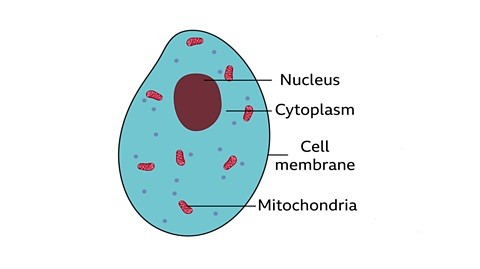
Nucleus, Protoplasm, Mitochondria, Cell membrane
-
What is a cell?
A basic unit of all living things. As a basic functional unit, the cell is responsible for carrying on all life processes. There are trillions of cells in the human body, and they wary widely in size, shape, and purpose.
-
Cell Nucleus
The dense, active protoplasm found in the center of the cell. It plays an important part in cell reproduction and metabolism. Within the nucleus is the nucleoplasm which is a fluid that contains proteins, and a very important acid known as deoxyribonucleic acid (DNA). DNA is what determines our genetic makeup.
-
Protoplasm
A watery gel-like fluid containing the nutrient material necessary for cell growth, reproduction and self repair.
-
Mitochondria
Serves to take in nutrients, break them down, and create energy. This chemical energy used within cells for metabolism is called ATP (adenosine triphosphate). Mitochondria are organelles floating freely throughout the cell. Some cells, like muscle cells, have several thousand mitochondria. Others, like blood cells, have none. Neurons don't need as many cells as muscles because they use less energy.
-
Cell Membrane
Part of the cells that encloses the protoplasm and permits soluble substances to enter and leave the. It is selectively permeable, controlling the introduction of beneficial substances into the cell and the removal of waste and substances that do not benefit the life of the cell. The cell. membrane protects the cell from its surroundings. It also communicates with other cells, linking like cells together to form tissues.
-
Mitosis
The normal process of cell reproduction in tissues that occurs when the cell divides into two identical cells called daughter cells.
Favorable conditions for cell reproduction: adequate supply of nutrients, oxygen, water; ability to eliminate waste; ideal temps.
Unfavorable: present toxins, disease, injury
-
Cell Metabolism
Chemical process that takes place in living organisms. It concerts nutrients to energy so the cell can function. It also eliminates waste. These functions allow organisms to grow and reproduce, respond to their environments, and maintain their structures.
-
Why is understanding cell metabolism important?
Aging influences the cell's metabolism and the cell begins to function less efficiently. Cell metabolism is something you will consider when working with your clients. Clients' response to treatment and response to active ingredients in products will be influenced by the efficiency and speed of their metabolism.
-
List the four types of tissue found in the body.
Connective Tissue
Epithelial Tissue
Muscle Tissue
Nerve Tissue
-
What is tissue?
A collection of similar cells that perform a particular function. Each tissue has a specific function and are recognized by its characteristic appearance. There are FOUR types of tissue in the body.
-
Connective Tissue
Supports, protects, and binds together other tissues of the body.
E.g. bone, cartilage, ligaments, tendons, fascia, blood and fat, which is also called adipose tissue. (stores energy and gives smoothness/contour to the body)
Collagen and elastin are protein fibers, and are also connective tissue.
-
Epithelial Tissue
Protective lining on cavities of the body and surfaces of organs.
E.g. skin, mucous membranes, lining of the heart, digestive and respiratory organs, and the glands.
-
Muscle Tissue
Contracts and moves the various parts of the body.
-
Nerve Tissue
Carries messages thought the central nervous system to control and coordinate all bodily functions. Nerve tissue is composed of special cells called neurons, which make up the nerves, brain and spinal cord.
-
What are functions in the body carries out by?
Organs
-
What are Organs?
A collection of tissues that have an identifiable structure and perform specific functions.
-
Define Body Systems
A group of organs acting together for one or more functions.
-
Integumentary System
Largest organ of the body. First line of defense against infection and water loss; regulates temperature, perceives sensation, produces vit. D; absorption capabilities.
E.g. skin & accessory organs (oil and sweat glands), sensory receptors, hair and nails.
Why know this? As it is largest organ learning its functions and the work of the accessory organs is a critical component in a skincare therapist's success
-
Skeletal System
Forms physical foundation of the body.
Consists of the bones and movable and immovable joints.
Why know this? Important for protecting your own body mechanics when working, as well as knowing physical landmarks when providing treatments, including makeup applications.
-
Muscular System
Covers, shapes, & supports the skeletal tissue; also contracts and moves the various parts of the body.
Consists of muscles.
Why know this? Important when doing massages and performing electrical treatments such as micro-current; also to understand muscle movement to prevent repetitive motion fatigue when performing treatments.
-
Nervous System
Carries messages though the central nervous system, controlling and coordinating all bodily functions.
Consists of brain, spinal cord, nerves.
Why know this? Need to know location of facial nerves and their actions when performing treatments; nerves control muscle movements of the face.
-
Circulatory System
Controls the steady delivery of the blood though the body; works with the lymphatic channels.
Consists of heart with blood vessels.
Health of this system affects skin tissue health; circulatory issues are often contraindications and precautions to treatments; when performing body wraps for example, understanding which directions to wrap is essential for a good outcome, or an adverse event can occur.
-
Immune/ Lymphatic System
Protects body from disease by developing resistances and destroying disease- causing toxins, foreign material, and bacteria.
Consists of spleen, lymph.
Many treatments require action from the lymphatic system, including performing lymphatic massage.
-
Endoctrine System
Affects growth, development, sexual activities, and normal regulatory processes of the body.
Consists of adrenal gland, pituitary gland, pancreas.
Hormones excreted by this system have a significant effect on the skin, and an understanding of that functioning will help when recognizing the need to refer a client for medical eval. Acne breakouts, hair growth, skin oiliness and dryness are a few.
-
Reproductive System
Performs function of reproduction and passing on genetics to future generations; differentiates between sexes.
Consists of uterus, ovaries, penis, testes.
This system and hormonal influences accompanying puberty, pregnancy, peri menopause, and menopause make significant demands on the skin that require knowledge in order to provide a skin-care treatment.
-
Respiratory System
Enables breathing, supplies the body with oxygen, and eliminates carbon dioxide as a waste product.
Consists of lungs, trachea, and bronchi
Adequate oxygenation of the tissue allows optimum cell functioning; possibility of the respiratory spread of infection affects safety and cleanliness.
-
Digestive System
Creaks down food into smaller and smaller particles to absorb nutrients or for excretion.
Consists of esophagus, stomach, gall bladder, liver, small and large intestines.
Good nutrition allows optimum functioning of all body systems.
-
Excretory System
Refers to elimination of waste matter
Consists of kidneys, bladder
Functions to eliminate toxic substances that can affect ofther body system functions.
-
What is osteology?
The study of the structure and function of the skeleton and bony structures.
-
List 5 accessory organs to the skin.
Sensory receptors, hair, nails, oil glands and sweat glands
-
What are the primary functions of the skeletal system?
- Gives shape and support to the body
- Protect various internal structures and organs
- Serve as attachments for muscles and act as levers to produce movement
- Help produce white and red blood cells (function of marrow
- Store most of body's calcium supply, as well as phosphorous, magnesium and sodium.
-
How many bones are in an adult skeleton?
206
-
What is a joint? Approximately how many joints does the body have?
The place where bones meet one another is typically called a joint. The body has over 230 joints
-
How many bones are in the human head?
22 bones
-
List bones in the skull. (Cranial bones)
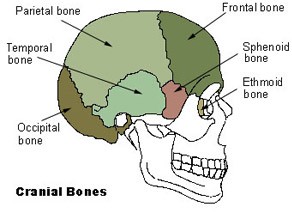
Parietal (2)
Temporal (2)
Frontal (1)
Occipital (1)
Ethmoid (1)
Sphenoid (1)
-
List bones in the face.
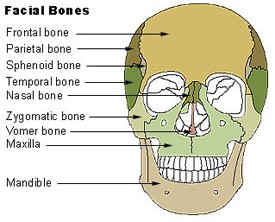
Maxillary (2)
Zygomatic (2)
Mandible (1)
Nasal (2)
Platine (2)
Inferior nasal concha (2)
Lacrimal (2)
Vomer (1)
-
List bones of the neck.
Hyoid (Adam's apple)
Cervical vertebrae
-
List bones of chest
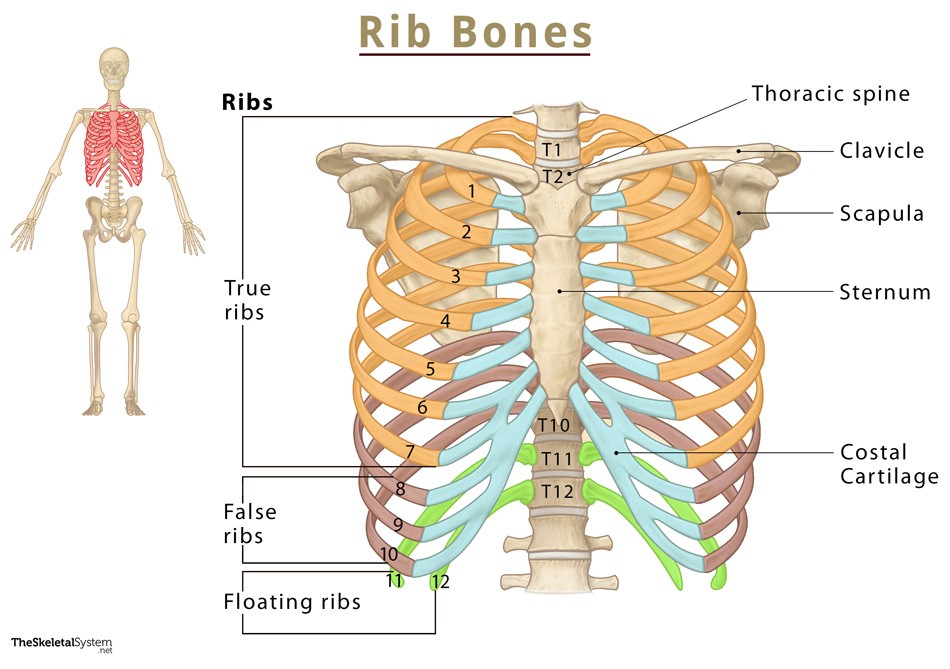
Ribs (12 pairs)
Scapula
Sternum
Clavicle
-
List bones of arms and hands
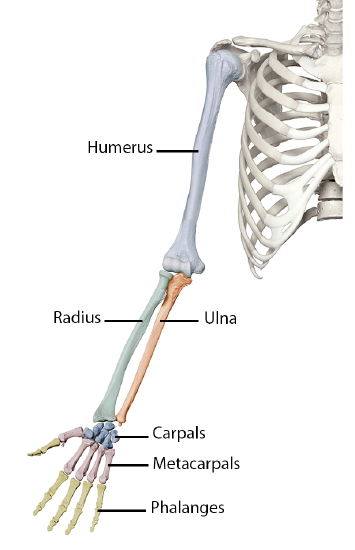
Humerus
Radius
Ulna
Carpus (8)
Metacarpus (5)
Phalanges (14)
-
How many muscles are in the human body? How many of those are facial muscles?
The body has 630 muscles. 30 of those muscles are facial muscles.
-
List three types of muscle tissue.
1. Skeletal - voluntary muscles that contract w conscious thought
2. Smooth - involuntary muscles not under conscious control
3. Cardiac - specific to heart function and not under conscious control.
-
List parts of a skeletal muscle.
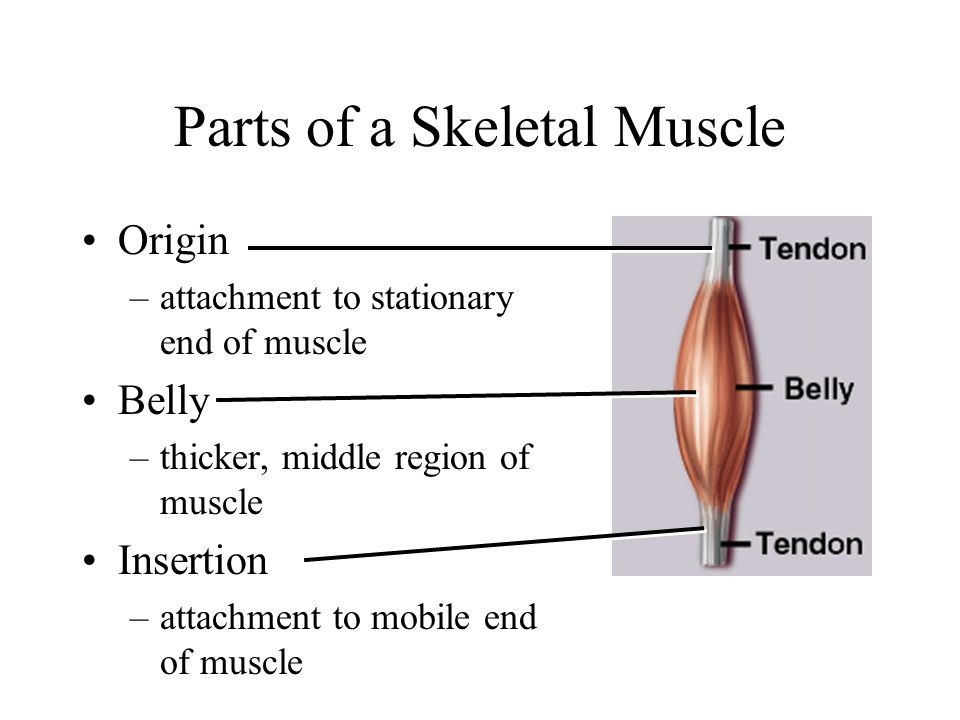
-
List muscles of the scalp

Frontalis - raises eyebrows; draws scalp forward
Temporalis (2)
Occipitalis - draws scalp backwards
Epicranius consists of both the frontalis and occipitalis
-
List muscles of the eyebrow
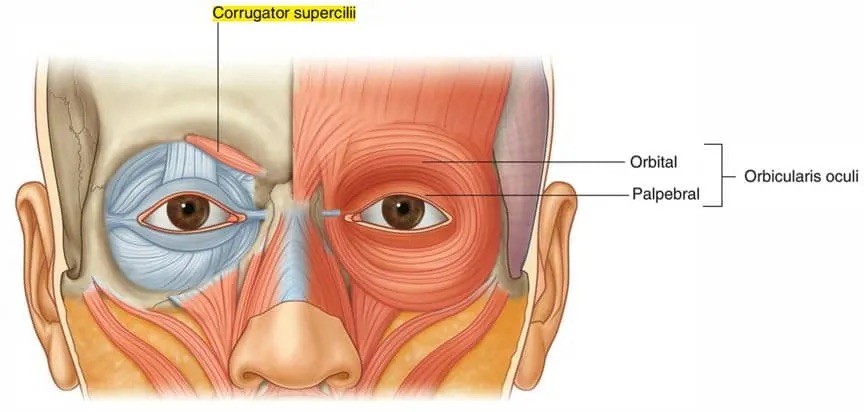
The corrugator - Draws eyebrow down and wrinkles forehead vertically.
The orbicularis occuli - Ring muscle around eyesocket. Closes the eye
The levator palpabrae superioris muscle - lifts the eyelid
-
List muscles of the nose.
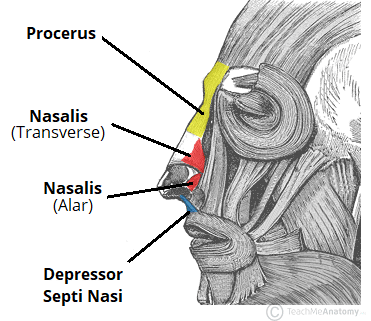
The procerus lower eyebrows and wrinkles the top of nose.
The nasalis is a two-part muscle that covers nose. Flairs the nostrils

